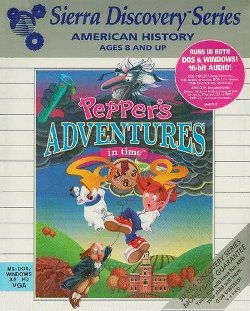Pepper's Adventures in Time facts for kids
Quick facts for kids Pepper's Adventures in Time |
|
|---|---|
 |
|
| Developer(s) | Sierra On-Line |
| Publisher(s) | Sierra On-Line |
| Producer(s) | Mark Seibert |
| Designer(s) | Gano Haine Jane Jensen Josh Mandel Lorelei Shannon Bill Davis |
| Programmer(s) | Juan Carlos Escobar |
| Artist(s) | James Larsen Tony Margioni |
| Writer(s) | Lorelei Shannon |
| Composer(s) | Neal Grandstaff |
| Platform(s) | MS-DOS, Windows |
| Release date(s) |
|
| Genre(s) | Adventure, Educational |
| Mode(s) | Single-player |
Pepper's Adventures in Time is an exciting educational game and adventure game. It was released in 1993 by a company called Sierra On-Line. The idea for the game came from Bill Davis, who also created the main characters.
This game was meant to be the first in a series of "edutainment" games. These games would let players travel through time as a character named Pepper. Their mission would be to fix historical events that got mixed up. The game's early name was "Twisty History." It was the third game in Sierra's Discovery Series.
Exploring the Story and How to Play
The game follows a brave young girl named Pepper. She has a loyal pit bull dog called Lockjaw. Pepper's Uncle Fred builds a time machine. Accidentally, Lockjaw gets thrown into its portal! Pepper jumps in after him, hoping to save her dog.
They both end up in Philadelphia in the year 1764. But something is wrong with history! Many things from the 1960s American counterculture are mixed with the life of Benjamin Franklin. He has become a "flower child" or "hippie"!
Pepper must talk to the townspeople and Benjamin Franklin. She needs to make sure history happens the way it should. She also has to find Lockjaw and reunite with him.
Players can learn real historical facts while playing. There is a special "truth" icon that helps with this. At the end of each part of the game, you can take multiple-choice quizzes. These quizzes test what you've learned about history.

